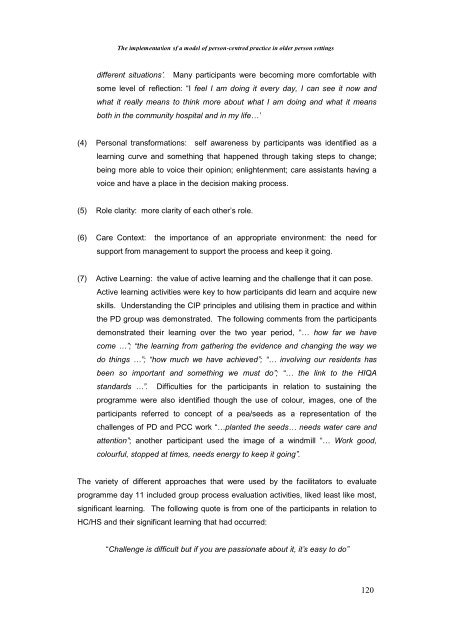The Implementation of a Model of Person-Centred Practice In Older ...
The Implementation of a Model of Person-Centred Practice In Older ...
The Implementation of a Model of Person-Centred Practice In Older ...
Create successful ePaper yourself
Turn your PDF publications into a flip-book with our unique Google optimized e-Paper software.
<strong>The</strong> implementation <strong>of</strong> a model <strong>of</strong> person-centred practice in older person settings<br />
different situations’. Many participants were becoming more comfortable with<br />
some level <strong>of</strong> reflection: “I feel I am doing it every day, I can see it now and<br />
what it really means to think more about what I am doing and what it means<br />
both in the community hospital and in my life…’<br />
(4) <strong>Person</strong>al transformations: self awareness by participants was identified as a<br />
learning curve and something that happened through taking steps to change;<br />
being more able to voice their opinion; enlightenment; care assistants having a<br />
voice and have a place in the decision making process.<br />
(5) Role clarity: more clarity <strong>of</strong> each other’s role.<br />
(6) Care Context: the importance <strong>of</strong> an appropriate environment: the need for<br />
support from management to support the process and keep it going.<br />
(7) Active Learning: the value <strong>of</strong> active learning and the challenge that it can pose.<br />
Active learning activities were key to how participants did learn and acquire new<br />
skills. Understanding the CIP principles and utilising them in practice and within<br />
the PD group was demonstrated. <strong>The</strong> following comments from the participants<br />
demonstrated their learning over the two year period, “… how far we have<br />
come …”; “the learning from gathering the evidence and changing the way we<br />
do things …”; “how much we have achieved”; “… involving our residents has<br />
been so important and something we must do”; “… the link to the HIQA<br />
standards …”. Difficulties for the participants in relation to sustaining the<br />
programme were also identified though the use <strong>of</strong> colour, images, one <strong>of</strong> the<br />
participants referred to concept <strong>of</strong> a pea/seeds as a representation <strong>of</strong> the<br />
challenges <strong>of</strong> PD and PCC work “…planted the seeds… needs water care and<br />
attention”; another participant used the image <strong>of</strong> a windmill “… Work good,<br />
colourful, stopped at times, needs energy to keep it going”.<br />
<strong>The</strong> variety <strong>of</strong> different approaches that were used by the facilitators to evaluate<br />
programme day 11 included group process evaluation activities, liked least like most,<br />
significant learning. <strong>The</strong> following quote is from one <strong>of</strong> the participants in relation to<br />
HC/HS and their significant learning that had occurred:<br />
“Challenge is difficult but if you are passionate about it, it’s easy to do”<br />
120
















